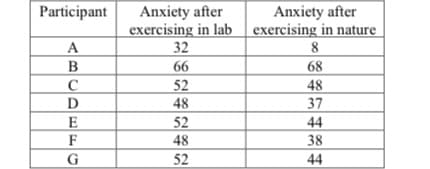Exercise is known to produce positive psychological effects. Interestingly, not all exercise is equally effective. It turns out that exercising in a natural environment (e.g., jogging in the woods) produces better psychological outcomes than exercising in urban environments or in homes (Mackay & Neill, 2010). Suppose that a sports psychologist is interested in testing whether there is a difference between exercise in nature and exercise in the lab with respect to post-exercise anxiety levels. The researcher recruits n = 7 participants who exercise in the lab and exercise on a nature trail. The data below represent the anxiety scores that were measured after each exercise session. a. For this repeated-samples design, test the hypothesis that post-exercise anxiety is lower when people exercise in nature than when they exercise indoors (in the lab). Use ? = .05, two-tailed. Make certain to follow the steps shown in the course lecture slides and textbook. Use the computational formula for SS. Show all your work and include a distribution with the locations of obtained and critical t. b. Compute Cohen’s d and give the size of the effect. c. Write the results as they would appear in a scientific journal article.
Exercise is known to produce positive psychological effects. Interestingly, not all exercise is equally effective. It turns out that exercising in a natural environment (e.g., jogging in the woods) produces better psychological outcomes than exercising in urban environments or in homes (Mackay & Neill, 2010). Suppose that a sports psychologist is interested in testing whether there is a difference between exercise in nature and exercise in the lab with respect to post-exercise anxiety levels. The researcher recruits n = 7 participants who exercise in the lab and exercise on a nature trail. The data below represent the anxiety scores that were measured after each exercise session.
a. For this repeated-samples design, test the hypothesis that post-exercise anxiety is lower when people exercise in nature than when they exercise indoors (in the lab). Use ? = .05, two-tailed. Make certain to follow the steps shown in the course lecture slides and textbook. Use the computational formula for SS. Show all your work and include a distribution with the locations of obtained and critical t.
b. Compute Cohen’s d and give the size of the effect.
c. Write the results as they would appear in a scientific journal article.

Trending now
This is a popular solution!
Step by step
Solved in 2 steps with 1 images









